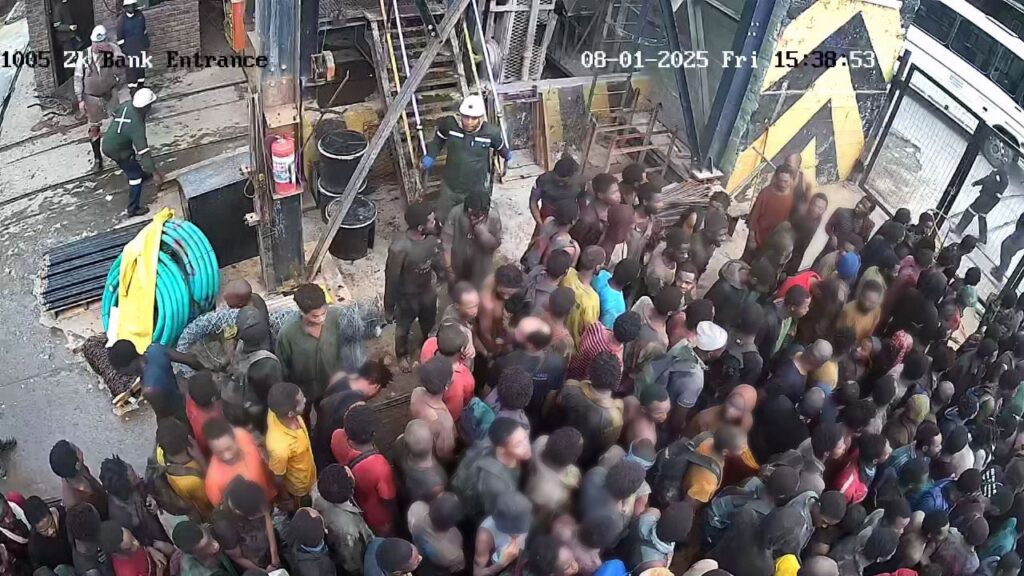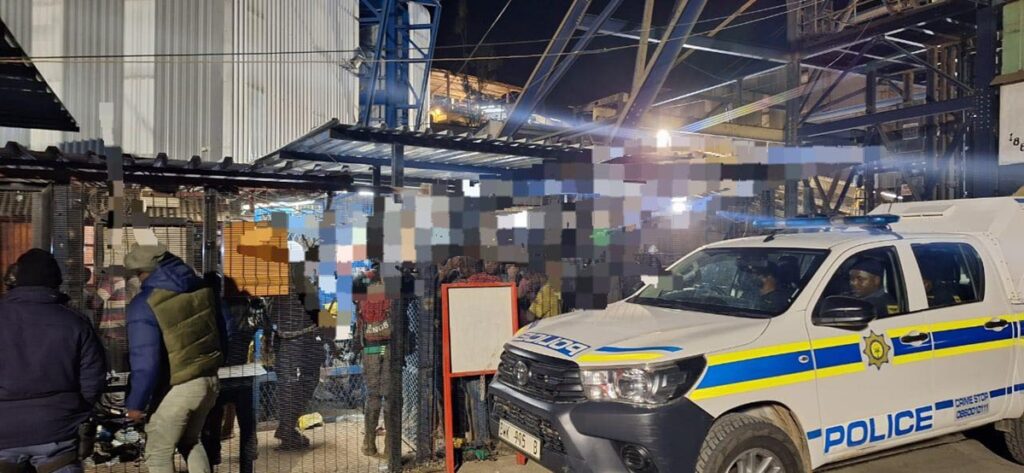Minors, undocumented migrants among 1000 illegal miners pulled from Mpumalanga shafts
BARBERTON, MPUMALANGA — A major police operation in Barberton has led to the arrest of approximately 1000 illegal miners, many of whom are undocumented foreign nationals. The operation, conducted under Operation Vala Umgodi, marks one of the largest crackdowns on illegal mining in South Africa in recent years.
The coordinated action involved multiple units from the South African Police Service (SAPS), including the National Roving Team, K9 Unit, Task Force, and members from Combat and Proactive teams. Private security firm Vukalanga Security also assisted, alongside officials from the Department of Home Affairs, the Department of Mineral Resources and Energy, and the National Prosecuting Authority.
The operation began quietly on Monday, 28 July 2025, with surveillance and intelligence-gathering. By Friday, 1 August, officers were deployed on the ground, forcing 1,000 illegal miners to abandon their underground hideouts and surface, leading to their swift arrest.
A Long-Awaited Breakthrough in Barberton
Barberton, once a cornerstone of South Africa’s formal gold mining industry, has become a key battleground in the country’s ongoing struggle with illegal mining. Disused shafts and abandoned mining infrastructure have become prime territory for illegal operations — often referred to as zama zamas — that attract desperate individuals from across southern Africa.
Authorities believe that the 1000 illegal miners arrested this week were part of an extensive, well-organised underground network. Early indications suggest that most, if not all, were foreign nationals lacking documentation to be in the country legally. According to SAPS, several of those taken into custody may be underage, raising concerns about child labour and exploitation in the mining underworld.

Who Are the 1000 Illegal Miners?
While SAPS is still verifying the nationalities of those arrested, officials from Home Affairs have confirmed that the majority are believed to be from Zimbabwe, Mozambique, and Lesotho. Some were found in possession of forged identification documents, while others had none at all.
A source within the local Home Affairs office, speaking on condition of anonymity, said that “at least a dozen” of the suspects appear to be minors. “We’re working through the proper processes now to determine their ages and backgrounds, but the presence of children among these miners is deeply troubling,” the source said.
The arrest of 1000 illegal miners has also reignited debate around border control and the challenges South Africa faces in managing undocumented immigration — particularly in economically vulnerable regions like Mpumalanga.
Also Read | Cough Syrup Worth R819K Seized in Booysens, 2 Zimbabweans Arrested
Operation Vala Umgodi: Strategy and Execution
Operation Vala Umgodi was launched as a focused effort to disrupt illegal mining across multiple provinces, with Mpumalanga being among the worst-affected. The scale of this particular raid, however, has exceeded expectations.
Acting Provincial Commissioner of SAPS in Mpumalanga, Major General (Dr.) Zeph Mkhwanazi praised the success of the joint operation.
“Barberton has been giving us a challenge in terms of crime. We previously made a commitment to heighten our visibility in the area, with continuous operations being carried out. We are not reluctant when a person is found on the wrong side of the law — we arrest, end of the story,” he said.
The operation’s success was made possible through close cooperation with the local mine, whose management provided intelligence and access to affected areas. Law enforcement agencies have confirmed that the 1000 illegal miners had been working in extremely dangerous conditions, without any protective gear, and without regard for the structural safety of the tunnels they operated in.
Legal Consequences for the 1000 Illegal Miners
The suspects face multiple charges, including contravention of the Immigration Act, illegal mining, and trespassing. Additional charges may follow as investigations continue.
SAPS has confirmed that all 1000 illegal miners will be processed and appear before the court. For those confirmed to be minors, the Department of Social Development will intervene. Undocumented adults will likely be handed over to Home Affairs for deportation procedures once legal processes have been completed.
The Department of Mineral Resources and Energy will also be involved in assessing the damage caused to the mine infrastructure and whether any recoverable value was extracted during the illegal operations.

A Community Under Siege
Residents in Barberton have expressed a mixture of relief and scepticism. While many are glad to see law enforcement finally responding in force, others question how long the reprieve will last.
“We’ve seen raids before, and a few months later the zama zamas are back,” said one resident, who asked not to be named. “Unless the government deals with the syndicates funding these operations, arresting 1000 illegal miners won’t stop the next 1,000 from coming.”
Local councillors have echoed the call for deeper investigations, particularly into the networks that supply equipment, food, and logistics to the illegal miners. There are growing concerns that these operations are being financed and coordinated by well-established criminal groups, not just individuals seeking economic survival.
Is SAPS Winning the War?
Friday’s operation may be a landmark success, but experts warn that illegal mining is a symptom of larger, structural issues — including poverty, unemployment, and the collapse of border enforcement.
Political analyst Bheki Nxumalo says the arrest of 1000 illegal miners will resonate in the short term, but the root causes remain unaddressed.
“This is not just a law enforcement issue. It’s economic. As long as there are hungry people and abandoned mines, illegal mining will continue,” he said.
He also pointed out that many former mineworkers, left unemployed after closures, now find themselves either complicit or powerless as their communities are taken over by underground economies.
What Happens Next?
Authorities say the operation will continue in surrounding areas and that surveillance has been expanded to identify remaining suspects who may have escaped during the raid. SAPS has not ruled out the possibility of further arrests.
Meanwhile, officials from the Department of Mineral Resources are expected to inspect the mine to assess long-term risks. Rehabilitation efforts, already underfunded, may need to be fast-tracked if the site is to be secured against future exploitation.
As the dust settles in Barberton, the arrest of 1000 illegal miners has exposed the scale of South Africa’s illegal mining crisis — and raised fresh questions about whether short-term operations can solve a long-term problem.








Leave a Reply